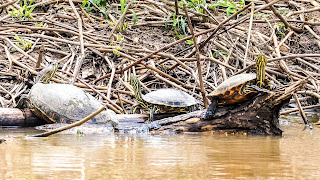We were up pretty early for today’s excursion. We had a two-hour drive into the countryside, heading north. The Caño Negro Reserve that we are visiting is only a few miles from the Nicaraguan border.
The Caño Negro
Reserve is a Ramsar Wetland. The Ramsar Convention
is an international treaty that identifies wetlands of great importance to
wildlife. (Ramsar is the name of the town
in Iran where the convention was signed.)
The drive took us through many sugar cane fields.
We also so living fences…where branches of trees are planted in the ground and they become living fences.
Many of them are Poro Trees. Also known as the Coral Trees they have pink/coral flowers on them.
We also saw a low lying area in a field that had many waterfowl, mostly white.
Once we arrived at our destination we boarded our boat on the Rio Frio. Photos we took of the Rio Frio throughout our cruise.
There was a lot of wildlife to be seen.
There were a
lot of tiny Mangrove Swallows darting around us up and down the river. We took several hundred photos. Most were of the muddy water. If we were lucky it was muddy water and a blurry
blob of a bird. These were the best we
could do.
We also saw a lot of Anhingas (or Snake Birds).
We saw Howler Monkeys,
Spectacled Caiman (so named for the bony protrusion around their eyes)
Cattle Egrets
Crested Caracara
Southern Lapwing
Great Egrets, a really majestic bird
Little Blue Heron
Amazon Kingfisher
Jesus Christ Basilisk
Black Vulture
Boat-Billed Night Heron
White Faced Capuchin Monkeys
Baby Caiman
Iguana
Dragonfly
Norther Jacana
Nicaraguan Turtles
Spider Monkeys (our first sighting of these and they are the largest monkey species in Costa Rica),
and White Ibis.
We also saw an American Pygmy Kingfisher. Paul was the first to spot this and the guide said he made his day. This tiny bird (about the size of a hummingbird) is very hard to spot.
And, we saw an Orange Howler Monkey. There very few Howlers of this color. The color is due to a genetic mutation. Scientists are unclear as to what causes it but some think it might be due to exposure to pesticides. These are extremely rare in the wild as the coloring makes them easy to find by predators.
This old guy has survived well and has only recently lost his dominance in the local family when he was ousted by a younger, stronger male. But he hangs close to the family. It didn't take our guide and captain long to find him.
After lunch beside the river we visited a nearby farmer who showed us how they extract sugar juice from the sugar cane. We were amazed at how much juice came out of the canes.
Video of extracting juice from sugar cane
***************************************************
He also told us about how the roast coffee and cacao to make chocolate.
And we got a
few samples.
Then it was a two-hour
drive back to La Fortuna. We got back
late afternoon and then headed to the pool for dinner there. Took forever for the food to come out. But
the location was nice.




































































No comments:
Post a Comment